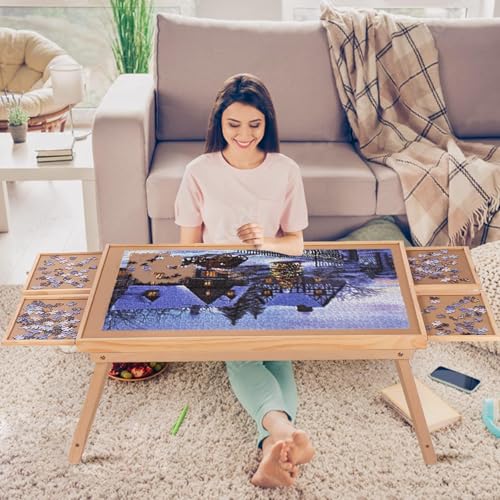This post may contains affiliate links which means I may receive a commission from purchases made through links. Learn more on my private policy page.
This post may contain affiliate links, which means I may receive a commission for purchases made through these links — at no extra cost to you. As an Amazon Associate, I earn from qualifying purchases.
There’s something so simple — yet so magical — about sitting down with a good puzzle. Whether it’s a chunky wooden puzzle for toddlers or a 1,000-piece masterpiece for adults, puzzles have this quiet power to calm the mind, boost focus, and bring people together.
In our home, puzzles have always been more than just “toys.” They’re our go-to on slow afternoons, rainy weekends, and cozy evenings when we just want a screen-free activity that everyone can enjoy. Solving puzzles together has become our little family ritual — a way to slow down, reconnect, and learn side by side, one piece at a time.
🌱 My Kids’ Puzzle Journey
Both of my kids started playing with puzzles when they were about a year old — just simple blocks and shape sorters back then. Those little toys were more than just play; they helped them recognize shapes and colors, and quietly built their hand-eye coordination without them even realizing it.
Over the years, I’ve learned that it’s so important to pick the right puzzle for the right age. We want our kids to have just the right amount of challenge — enough to make them think and feel proud when they solve it — but not so hard that they end up frustrated or discouraged. When the puzzle matches their ability, they stay curious, focused, and eager to keep trying.
We started with chunky wooden puzzles like the Melissa & Doug Shape Sorting Cube, then slowly moved on to ones with animals, vehicles, and numbers. At first, they needed a bit of help figuring out where each piece went. But soon, something amazing happened — when I stepped back and let them work on their own, they’d sit quietly, concentrating, until they solved it all by themselves.
And when they did — the excitement on their faces was priceless! They’d proudly call me over to show their finished puzzle, and I could see how much confidence that small accomplishment gave them. Those little victories reminded me that puzzles aren’t just fun or educational — they teach patience, focus, and that sweet joy of saying, “I did it myself.”
As they got older, we started doing floor puzzles together. They learned to look for matching shapes, edges, and colors — working patiently and systematically. Sometimes they’d collaborate, sometimes they’d compete playfully, but they were always learning and so proud of their teamwork.
And honestly, puzzles slow me down, too. When we sit together on the floor, there’s no rushing. We talk — sometimes about school, sometimes about something completely silly — just slow, gentle conversations that happen naturally when our hands are busy and our minds are calm. Those quiet moments have become some of my favorite memories with them.
🧠 Why Puzzles Are So Important in Development
Puzzles might seem like simple entertainment, but they’re actually powerful tools for both mental and emotional growth.
1. Builds Problem-Solving and Critical Thinking
Each puzzle piece is a tiny challenge that encourages logical thinking and persistence. Kids learn to test, adjust, and keep trying until things fit.
2. Teaches Patience and Concentration
Puzzles naturally slow the pace. In a world of instant results, this quiet process teaches children (and adults!) to enjoy focus, patience, and progress.
3. Strengthens Fine Motor Skills
For younger kids, fitting pieces together improves coordination, control, and grip strength — essential skills for writing and daily tasks.
4. Improves Spatial and Visual Memory
Matching shapes, colors, and patterns helps kids understand how parts connect to form a whole — skills that support math, art, and science later in life.
5. Builds Emotional Resilience
Puzzles teach kids (and even us) to handle frustration. That sense of achievement when the last piece clicks in — it’s confidence in its purest form.
💼 Puzzles at Work: A Lesson in Teamwork
Puzzles aren’t just for kids — they’re just as good for adults.
In my husband’s office, the staff keeps a 1,000-piece puzzle on a common table. Whenever someone needs a quiet moment to relax or unwind, they’ll stop by, pick up a few pieces, and start sorting. It’s become a peaceful ritual — a simple way to de-stress between tasks.
By the end of the week, the puzzle is usually complete. They display it proudly for a few days before starting a new one — a little reminder of teamwork, patience, and the idea that when everyone contributes a small part, something beautiful comes together.
It’s such a wonderful metaphor for life and work — piece by piece, together, we create something meaningful.
And puzzles don’t stop being good for us once we grow up — they continue to offer amazing benefits in later years, too. From keeping the mind sharp to bringing comfort and calm, puzzles truly grow with us at every age.
🌈 The Right Puzzle for Every Age
| Age Group | Best Puzzle Type | What It Teaches |
|---|---|---|
| 1–3 years | Shape sorters, chunky wooden puzzles | Hand-eye coordination, shape recognition |
| 3–5 years | 12–24 piece puzzles, alphabet puzzles | Fine motor skills, color & pattern recognition |
| 6–8 years | 50–100 piece puzzles, floor puzzles | Teamwork, focus, logical reasoning |
| 9+ years | 300–1000 piece puzzles, 3D or themed sets | Problem-solving, patience, visual memory |
| Adults | Complex jigsaws | Stress relief, mindfulness, teamwork |
🛍️ Shop our favorite puzzles by age below :
1–3 years
3–5 years
6–8 years
9+ years
Adults
💛 Mom Tip
Keep a few puzzles handy — they’re perfect for quiet play or after-screen “reset time.”
And if space is tight, a puzzle mat is a lifesaver. You can easily roll up unfinished puzzles and continue later without losing any pieces.
But if you or your kids are serious about puzzles and want to dedicate a little corner of your home just for it, consider getting a puzzle table. These tables make puzzling more comfortable — no bending over the floor — and some even come with drawers, covers, and wheels so you can move your work easily from one room to another. They’re also wonderful for grandparents or anyone who prefers a stable, adjustable surface.
For even better comfort, you can pair it with a Modern LED Floor Lamp for Reading — a bright, dimmable light with adjustable gooseneck that helps reduce eye strain and makes puzzle time more enjoyable. It’s perfect for a cozy living room corner, office, or study area.
👉 Our favorites:
🌟 Final Thoughts
Puzzles are more than a pastime — they’re quiet teachers of patience, focus, and perseverance. They help kids learn and adults recharge.
Whether it’s a toddler fitting their first wooden shape, a family chatting while working on a floor puzzle, or office colleagues completing a 1,000-piece masterpiece — puzzles remind us of something powerful: every piece matters, and when we take time to slow down, connect, and work together, the picture becomes complete. ❤️




































